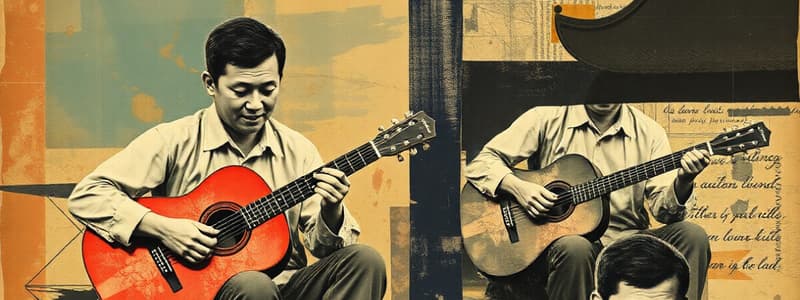Podcast
Questions and Answers
What natural materials are predominantly used in the musical instruments of Southeast Asia?
What natural materials are predominantly used in the musical instruments of Southeast Asia?
- Stone and clay
- Synthetic fibers and rubber
- Bamboo, wood, and metals (correct)
- Plastic and glass
What is the primary cultural characteristic of the Gamelan ensemble in Indonesia?
What is the primary cultural characteristic of the Gamelan ensemble in Indonesia?
- It is known for its non-metallic instruments.
- It consists of bronze or iron idiophones and is considered sacred. (correct)
- It mostly features vocal performances with minimal instruments.
- It is a secular music style popular in urban areas.
Which of the following instruments is part of the Gamelan ensemble?
Which of the following instruments is part of the Gamelan ensemble?
- Bonang (correct)
- Piano
- Drum set
- Violin
What themes are commonly found in songs written by Southeast Asian cultures?
What themes are commonly found in songs written by Southeast Asian cultures?
How are Gamelan instruments treated by musicians?
How are Gamelan instruments treated by musicians?
What is the main instrument that dominates Thailand’s Piphat Ensemble?
What is the main instrument that dominates Thailand’s Piphat Ensemble?
Which type of meter is primarily used in the music of Thailand’s Piphat Ensemble?
Which type of meter is primarily used in the music of Thailand’s Piphat Ensemble?
What is the purpose of the khawng wong yai in Thailand’s Piphat Ensemble?
What is the purpose of the khawng wong yai in Thailand’s Piphat Ensemble?
How many instruments are typically included in Cambodia’s Pinpeat Ensemble?
How many instruments are typically included in Cambodia’s Pinpeat Ensemble?
What classification does Cambodia's Pinpeat Ensemble fall under?
What classification does Cambodia's Pinpeat Ensemble fall under?
What characterizes the pieces played by Thailand’s Piphat Ensemble?
What characterizes the pieces played by Thailand’s Piphat Ensemble?
What is a significant aspect of vocal music in Southeast Asia?
What is a significant aspect of vocal music in Southeast Asia?
In the context of the Piphat Ensemble, what role does the instrument 'ching' play?
In the context of the Piphat Ensemble, what role does the instrument 'ching' play?
What is the primary activity that each group is required to undertake regarding their assigned folk song?
What is the primary activity that each group is required to undertake regarding their assigned folk song?
Which of the following countries is NOT assigned as a group in the activity?
Which of the following countries is NOT assigned as a group in the activity?
What is the goal of the group activity centered around folk music?
What is the goal of the group activity centered around folk music?
What type of climate does Southeast Asia experience that influences its trade?
What type of climate does Southeast Asia experience that influences its trade?
Which activity follows the research and is central to the group’s presentation?
Which activity follows the research and is central to the group’s presentation?
What unique aspect is required in the group presentation about the folk song?
What unique aspect is required in the group presentation about the folk song?
Why did traders and explorers wish to establish trade with Southeast Asian countries?
Why did traders and explorers wish to establish trade with Southeast Asian countries?
Which of the following best describes the overall purpose of the lesson on folk music and arts?
Which of the following best describes the overall purpose of the lesson on folk music and arts?
Flashcards
Portuguese and Dutch Influence in Southeast Asia
Portuguese and Dutch Influence in Southeast Asia
Portuguese and Dutch traders established colonies in Southeast Asia and brought their culture, including Christianity, to the region.
British and French Influence in Southeast Asia
British and French Influence in Southeast Asia
British and French traders established colonies in Southeast Asia, primarily focused on trade.
Southeast Asian Music Instruments
Southeast Asian Music Instruments
Southeast Asian musical instruments were primarily made from natural materials, including bamboo, wood, and metal.
Gamelan Ensemble
Gamelan Ensemble
Signup and view all the flashcards
Sacred Gamelan Instruments
Sacred Gamelan Instruments
Signup and view all the flashcards
Southeast Asia
Southeast Asia
Signup and view all the flashcards
Folk Music
Folk Music
Signup and view all the flashcards
Cultural Importance
Cultural Importance
Signup and view all the flashcards
Traditional Instruments
Traditional Instruments
Signup and view all the flashcards
Indochinese Peninsula
Indochinese Peninsula
Signup and view all the flashcards
Insular Southeast Asia
Insular Southeast Asia
Signup and view all the flashcards
Rich Spices
Rich Spices
Signup and view all the flashcards
Exotic Goods
Exotic Goods
Signup and view all the flashcards
Slendro
Slendro
Signup and view all the flashcards
Pelog
Pelog
Signup and view all the flashcards
Piphat Ensemble
Piphat Ensemble
Signup and view all the flashcards
Khawng Wong Yai
Khawng Wong Yai
Signup and view all the flashcards
Khawng Wong Lek
Khawng Wong Lek
Signup and view all the flashcards
Duple Meter
Duple Meter
Signup and view all the flashcards
Pinpeat Ensemble
Pinpeat Ensemble
Signup and view all the flashcards
Oral Tradition
Oral Tradition
Signup and view all the flashcards
Study Notes
Grade 7 Unit 3: Exploring Folk Music and Arts, Philippines and Southeast Asia
- The central question is: How do the folk music and arts of the Philippines connect with those of selected Southeast Asian countries?
- Lesson 1: Harmonizing Cultures: Folk Music Artistry Across Southeast Asia
- Borobudur is a Buddhist temple in Central Java, Indonesia.
- The class will be divided into four groups: Philippines, Indonesia, Cambodia, and Thailand.
- Students will research a traditional folk song for their assigned country.
- This includes researching the song's history, cultural importance, interesting stories, and traditional instruments used.
- Students will practice singing or playing the folk song as a group.
- Students will create a presentation about their research, including details of history and cultural significance.
- Students will highlight unique aspects of the music.
- Students will practice performing their folk song as a group, focusing on capturing the essence and style of the music.
- Each group will present their folk song and explain its significance to the class.
- Southeast Asia includes the Indochinese Peninsula/Mainland (Cambodia, Thailand, Myanmar, Vietnam, Laos) and Insular Southeast Asia (Malaysia, East Timor, Singapore, Brunei, Archipelagos of Indonesia, Philippines).
Regional Characteristics
- The region has a tropical climate, often hot and humid.
- The climate creates a rich variety of spices and exotic goods, including rice, rubber, and petroleum.
- Traders and explorers were attracted to these resources.
Historical Influences
- India established trade and commerce in Southeast Asia, introducing traditions such as Hinduism, Buddhism, and Islam.
- Portuguese and Dutch traders converted parts of the region into colonies and had minimal cultural influence.
- Britain and France colonized and traded in parts of the region.
General Characteristics of Music in Southeast Asia
- Musical instruments are often made from natural materials found in the region (bamboo, wood, metal).
- Music often reflects animism, with chants and songs dedicated to nature and spirits.
- Music often focuses on agriculture, from rice planting songs to harvest songs.
- Some songs are prayers for a good harvest.
- Metal gongs are frequently used to communicate with or honor spirits, and often accompany rituals or processions.
Indonesia's Gamelan Ensemble
- Indonesia is the largest archipelago in the world.
- The Gamelan ensemble uses bronze gongs.
- Gamelan instruments are seen as sacred and have supernatural powers.
- Musicians treat instruments with respect and do not step over them before playing (or during a performance).
- Instruments include bronze or iron idiophones (known as metallophones).
- Key instruments (e.g., gong ageng, bonang, saron barung, gambang, rebab, and kendang).
- The tuning system includes Slendro (octave divided into five equidistant tones) and Pelog (seven-tone tuning).
Thailand's Piphat Ensemble
- Piphat is the country's most well-known ensemble.
- It features in theater performances, rituals, funerals, and court events.
- Musical pieces are continuous, busy, and non-directional.
- Double-reed aerophones/tuned idiophones are used.
- Keyed xylophone called the ranat ek is prominent.
- Two sets of the larger, lower-pitched khawng wong yai (basic melodies) and higher-pitched khawng wong lek (faster and more ornate melodies).
- The ching (a cup-shaped instrument) plays accents.
Cambodia's Pinpeat Ensemble
- Cambodian music often accompanies events, festivals, and rites.
- It is performed by the Pinpeat ensemble, which is one of the oldest ensembles.
- It employs a total of eight to ten instruments.
- Classified as "gong-chime" music.
- The instruments are similar to Thailand's Piphat Ensemble, but instruments have different names.
Vocal Music in Southeast Asia
- Southeast Asia has a rich vocal music tradition.
- Songs, traditions, and stories are often taught orally, passed down through listening and constant practice.
Kulintang
- A musical ensemble from The Philippines.
Studying That Suits You
Use AI to generate personalized quizzes and flashcards to suit your learning preferences.




